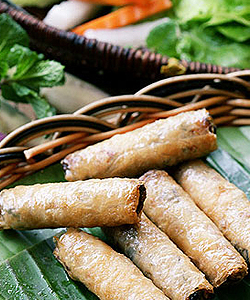
Vietnamese spring
rolls |
Vietnamese food is usually
considered one of the healthiest in the world as it is based on raw vegetables,
fresh herbs and seafood -- of which the country has an abundance -- and involves
little deep-frying. Yet there are very few Vietnamese restaurants in the city
while a number of other Southeast Asian ones seem to be more popular among
diners.
Now the wholesome Vietnamese cuisine has been introduced into the buffet
restaurant of the Renaissance Yangtze Shanghai Hotel and is served there through
this Saturday.
During my recent visit there, it was a pleasure to try the Vietnamese dishes
while sitting in a splendid, large dining room while surrounded by smiling
waitresses in Vietnamese dress and bamboo hats.
The first Vietnamese items served there were pawpaw juice and strawberry
juice, which were delightfully pure and refreshing. The strawberry juice, served
in a treamlined glass and decorated like a cocktail, tasted quite different from
any other strawberry drink I had ever tasted before. It was not particularly
sweet but naturally savoury and appetizing.
Pho, a kind of rice noodle with beef broth, is eaten throughout Viet Nam and
is one of the most typical and popular dishes in the country. Garnished with
bean sprouts and garlic, the noodle soup was topped with beef or chicken
according to diners'requirements and was prepared by the chef on the spot. The
dish was a wonderful combination of flavours, tasting spicy, sour and sweet at
the same time. All it lacked was caraway.
Another typical Vietnamese dish was spring rolls (called "cha gio"in Viet
Nam), including fried rolls wrapping shrimp and pork and uncooked ones
containing raw vegetable slices.
Unlike Chinese spring rolls, the Vietnamese ones are made of wafer-thin rice
paper and are usually accompanied by fish sauce -- a special condiment common in
Viet Nam -- and vinegar, salt and garlic. The vegetable spring rolls were cold
and crispy, with a very bland flavour, while those that were fried were
relatively small and the fillings were lightly flavoured.
The most impressive Vietnamese food I sampled on this occasion were the
salads, which came in four different varieties, all containing meat and
vegetables or fruit. The grapefruit salad was a very delicate combination of
grapefruit pieces and shrimp. The dish tasted a little bitter (due to the
grapefruit) but also had the natural flavour of anise and a little sweetness.
The other salads were delectable, including grilled eggplant with dried small
shrimp and fresh mint, green mango salad and chicken salad with cabbage.
The Vietnamese hot dishes were somewhat similar to other Asian dishes and
mostly cooked for a long time.
The fried crab was my favourite hot dish, visually splendid and
well-seasoned. According to the Vietnamese chef Tan, the crab was first soaked
in boiling oil for about one minute and then warmed for eight hours on a small
fire. The braised beef in red soup was another delicacy, served with tomato,
lemon grass and carrot slices which had been stewed for about four hours.
One of the desserts was quite similar to a Guangdong-style dessert and tasted
sweet and refreshing. It consisted of glutinous rice, served with corn and
drenched in coconut milk. The biggest difference between it and its Chinese
counterpart was that the dish was served warm.
According to Tan, each region in Viet Nam boasts its own local specialty and
flavours. Food in the northern part of the country is usually sour while dishes
in the central area are spicy, in the south sweet.
Renaissance Yangtze
Shanghai Hotel
Location: No.2499, Yanan Xilu
Tel: 021-62750000
Cost:
138 yuan (US$17) for lunch per person plus 15 per cent surcharge
178 yuan
(US$22) for dinner plus 15 per cent surcharge
Children under five, for
free